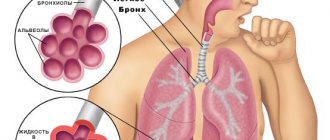Focal pneumonia is an infectious-inflammatory disease that does not affect all of the lung tissue, but only a certain area of it, forming into small-focal or large-focal inflammation in the lobules of the lung. This pathology can be either secondary, since it can be a consequence of many ailments, including bronchitis, or independent, since it can develop as a result of pathogenic bacteria entering the human body. Focal pneumonia is the most common type of pneumonia (about 60% of cases).
Focal pneumonia: causes of development
Focal pneumonia is most often a complication after a severe and long course or complete lack of proper treatment of another disease. Focal pneumonia can develop due to the following ailments:
- acquired heart disease;
- myocardial infarction;
- bronchitis;
- ARVI;
- benign or malignant tumors;
- whooping cough;
- measles;
- scarlet fever;
- meningitis;
- purulent otitis;
- acute catarrh of the respiratory tract;
- furunculosis;
- flu;
- sepsis;
- chlamydia;
- typhoid fever;
- osteomyelitis;
- peritonitis;
- chronic diseases of the lungs and respiratory organs;
- obstructive bronchitis;
- any other pathologies of a purulent or inflammatory nature.
Like many other ailments, focal pneumonia can also be caused by hypothermia, severe stress, nervous strain, inhalation of toxic substances and penetration of a foreign body into the lungs and bronchi.
Pathogenic agents that can cause focal pneumonia include:
- streptococci;
- staphylococci;
- pneumococci;
- E. coli;
- proteus and Friedlander's wand;
- viruses of groups A and B;
- adenovirus;
- microscopic fungi;
- rhinovirus;
- parainfluenza virus.
All of the above microorganisms are predisposing factors in the development of not only focal pneumonia, but also its community-acquired form. Pulmonologists at the Yusupov Hospital in Moscow are qualified specialists who will help identify the cause and form of the disease, as well as prescribe competent treatment for focal pneumonia in adults.
Also, in addition to the obvious reasons, it is worth noting the importance of factors influencing the development and progression of pneumonia. These include:
- decreased immunity;
- severe stress;
- lack of physical activity;
- previous surgical interventions on any internal organs;
- smoking;
- poor nutrition;
- overheating of the body;
- hypovitaminosis.
Focal pneumonia: symptoms and treatment
The onset of the disease, as a rule, begins asymptomatically. On the second or third day, primary manifestations of a viral infection appear:
- increased body temperature;
- runny nose;
- severe dry cough or with mucous sputum;
- general weakness;
- drowsiness;
- increased sweating.
For timely diagnosis of pneumonia, it is necessary to pay attention to the following further symptoms:
- dyspnea;
- very high temperature, which is difficult to get rid of (more than 38 degrees);
- tachycardia;
- low pressure;
- mucopurulent nature of expectorated sputum;
- pain and sensations of chest compression when breathing and coughing;
- burning when breathing;
- lack of appetite;
- wheezing during breathing;
- nausea, vomiting;
- diarrhea;
- chills;
- joint and muscle pain.
As a rule, during an examination, a pulmonologist can obtain an accurate picture of the disease, since pneumonia is characterized by wheezing in the pleural cavity, however, for an accurate result, X-rays, computed tomography, and a general blood test are often prescribed to exclude or confirm the presence of leukocytosis. It is possible to determine the etiology of the causative agent of the disease using microbiological examination of sputum. The Yusupov Hospital provides all the necessary equipment for examinations and tests, as well as a convenient service that allows you to contact our clinic daily, around the clock.
Pneumonia
Pneumonia (lung inflammation)
– an acute infectious-inflammatory disease of the lungs, in which all structural elements of the lung tissue are involved in the process.
Before the advent of antibiotics, pneumonia was one of the most dangerous diseases. The mortality rate from pneumonia at the end of the 19th century reached a record 83%. Today, despite all the achievements of modern medicine, the development of new antibacterial and antiviral drugs, this disease still remains a pressing problem: every year 14 out of 1000 people are diagnosed with pneumonia; In the structure of population mortality in the Russian Federation, pneumonia ranks fourth (9%), second only to cancer, cardiovascular diseases and injuries. Therefore, treatment of pneumonia requires mandatory monitoring and supervision by a specialist.
REASONS FOR THE APPEARANCE
Acute pneumonia is caused by various infectious agents. In approximately 90% of cases, these are bacteria, the remaining 10% are viruses, fungi, protozoa and helminths (roundworms, toxoplasma, schistosomes).
The most common pathogens include pneumococcus, Haemophilus influenzae, Mycoplasma pneumoniae, Staphylococcus aureus, influenza viruses and respiratory syncytial infection. Most often, pneumonia caused by these pathogens develops after suffering from hypothermia, or as a complication of acute respiratory viral infection.
CLASSIFICATION OF PNEUMONIA
Depending on the epidemiological conditions of the occurrence of pneumonia, they are divided into:
- Community-acquired (outpatient) - occur outside the hospital, or within 48 hours from the moment of admission to the hospital. They have a favorable prognosis.
- Intrahospital (hospital) - occur in a hospital setting, 48-72 hours after admission. The prognosis largely depends on the resistance of the pathogen to antibiotics.
- Pneumonia in patients with immunodeficiency conditions. The prognosis is unfavorable and requires active treatment in a hospital setting.
- Aspiration pneumonia is pneumonia caused by the contents of the gastrointestinal tract entering the respiratory tract.
Depending on the extent of the lesion and the mechanism of occurrence, it is customary to subdivide pneumonia into focal and lobar.
- Focal pneumonia is a variant of pneumonia with localization of the inflammatory process in a limited area of lung tissue, within the small structural units of the lung - lobules. Focal pneumonia usually develops as a complication of acute respiratory viral infection or acute tracheobronchitis. The clinical picture in this case may be “erased” and resemble a protracted course of bronchitis.
- Lobar pneumonia is an inflammation of the lung of an infectious nature, which is characterized by the involvement of one or more lobes of the lung, with the pleura covering them. The clinical picture is manifested by severe intoxication, intense cough, shortness of breath with tachypnea and tachycardia. Lobar pneumonia most often develops against the background of episodes of prolonged hypothermia.
In outpatient practice, cases of community-acquired pneumonia are most often encountered, which, with proper treatment, have a favorable prognosis.
SYMPTOMS OF PNEUMONIA
The clinical picture of pneumonia largely depends on the extent of the lesion. Manifestations of pneumonia are divided into pulmonary and extrapulmonary. Pulmonary manifestations include cough, chest pain, and shortness of breath. Extrapulmonary - fever, intoxication syndrome, laboratory inflammation syndrome.
Cough is a characteristic symptom of pneumonia. In the first or second day from the onset of the disease, the patient may only be bothered by a slight cough, later the cough becomes more intense, and mucopurulent sputum appears.
Chest pain is most typical for lobar pneumonia, because in this case, the pleura is involved in the inflammation process. Typically, such pain occurs suddenly and intensifies with the depth of inspiration. With extensive damage, the affected half of the chest may lag behind in the act of breathing.
Shortness of breath during pneumonia is most often associated with the volume of affected lung tissue. Thus, with small focal pneumonia, there is an increase in shortness of breath, accompanied by an increase in the frequency of respiratory movements to 30 per minute. At the same time, patients may complain of a feeling of chest congestion.
Intoxication with pneumonia is manifested by general weakness and muscle pain; at elevated temperatures, joint pain, increased sweating, headaches and decreased appetite may appear. In severe cases, confusion and delirium occur.
Fever with pneumonia can be an intermittent symptom. As a rule, at the beginning of the disease there is a rise in body temperature to 38-39 * C, which is stopped for a short time by antipyretics. But with a decrease in immunity, with extensive damage, pneumonia can occur without fever.
Laboratory signs will be leukocytosis in the blood (increased leukocyte levels above 11.0 * 10^9/l), increased levels of ESR, CRP, gamma and alpha2 globulins, seromucoid, but these indicators have low specificity.
DIAGNOSIS OF PNEUMONIA
Suspicion of pneumonia should arise if the patient has a fever, combined with complaints of a productive cough, discharge of mucopurulent sputum, shortness of breath and/or chest pain. Also, patients with pneumonia may complain of increased sweating at night, general weakness, fatigue, and increased blood pressure.
At the slightest suspicion of this disease, you should undergo additional examination. The minimum diagnostic minimum to confirm pneumonia should include a clinical blood test, a general urine test, a chest x-ray in two projections, as well as a consultation with a specialist, during which a general examination, palpation of the chest, percussion and auscultation of the lungs are performed.
In order to determine the pathogen and differential diagnosis with other diseases, the doctor may prescribe additional tests: general sputum analysis, sputum culture for sterility, serological tests, determination of IgG and IgM for individual pathogens, PCR diagnostics, MSCT of the chest with contrast, tuberculin tests, echocardiography and ECG.
TREATMENT
Most patients with community-acquired pneumonia can be treated at home, however, in each specific case, the prescription of antibiotics or antiviral drugs is determined by the etiological factor, medical history, examination data and the results of additional examination. Self-medication in the event of pneumonia is categorically prohibited, since improper therapy significantly increases the risk of death.
In some cases, patients require hospital treatment. Indications for hospitalization are extensive damage to the lung tissue, increasing symptoms of respiratory failure, and age over 60 years. Consultation with a therapist or pulmonologist in such situations is mandatory.
Prepared information for you:
Gusev-Shcherbakov Alexander Sergeevich
, general practitioner, conducting appointments in the clinic building on Usacheva
To make an appointment with a pulmonologist, call the single contact center in Moscow or use the online appointment service. Pulmonologist
Maria Yuryevna Konyukhova
conducts an appointment at the Family Doctor clinic on Baumanskaya.
Return to list
Focal pneumonia in adults: treatment
Treatment of focal pneumonia in adults at the Yusupov Hospital begins with a visit to a pulmonologist, who, depending on the classification of the disease, prescribes treatment. As a rule, conservative treatment of focal pneumonia consists of taking:
- antibacterial drugs. The fundamental factor for a speedy recovery is antibacterial therapy, which includes taking antibiotics prescribed individually. If no improvement occurs within 3 days, then it is necessary to change the drug;
- physiotherapy: therapeutic exercises, massages, inhalations, restoratives and medications;
- symptomatic therapy: antihistamines, anti-inflammatory drugs, expectorants, as well as mucolytics and bronchodilators;
- general rules: bed rest, high-calorie diet, drinking plenty of fluids, vitamin therapy, regular ventilation of the room.
Classification of pneumonia
Types of pneumonia are classified according to the cause. The type of microorganism involved, the location where the child was infected, and how the infection occurred are taken into account. According to the conditions of infection, hospital-acquired (nosocomial), intrauterine and community-acquired pneumonia in children is distinguished. The most common type of disease is the latter, which develops at home mainly against the background of ARVI.
Types of pneumonia in children according to the classification used in clinical practice:
· Focal.
The focus of infiltration has a diameter of 0.5 to 1 cm. Individual areas of infiltration can merge, which leads to the formation of a large focus.
· Segmental.
An entire segment of the lung may be involved in the inflammatory process. It is protracted and often complicated by fibrosis or deforming bronchitis.
· Croupous.
It is characterized by a hyperergic inflammatory process that affects the pleural area.
· Interstitial.
Accompanied by proliferation and infiltration of connective tissue. Develops when affected by fungi, viruses and pneumocystis.
According to the severity of the disease, complicated and uncomplicated pneumonia are distinguished. When complications develop, pulmonary edema, pulmonary insufficiency, pleurisy or abscess are observed. Cardiovascular disorders cannot be excluded.
Along the way, protracted and acute pneumonia in children are distinguished. In the second case, the disease resolves within 4-6 weeks. In a prolonged form, the inflammatory process persists for more than one and a half months. According to etiology, fungal, bacterial, viral and parasitic pneumonia are distinguished.
The clinical classification of childhood pneumonia is important for doctors, because, knowing the place and time of infection of the child, it is possible to determine the form of the pathogen that caused the pneumonia and, accordingly, prescribe effective treatment.
Complications after focal pneumonia
Complications after focal pneumonia most often develop as a result of incorrectly selected or untimely treatment. Possible complications after pneumonia include:
- toxic shock and sepsis;
- acute respiratory failure;
- anemia;
- pleurisy;
- myocarditis;
- abscess formation;
- gangrene;
- pulmonary hemorrhage;
- meningoencephalitis;
- glomerulonephritis;
- amyloidosis;
- pleural empyema;
- heart failure;
- burdening the work of the pulmonary system;
- transition of pneumonia to a chronic form;
- spread of a total infectious process throughout the body.
To avoid the development of secondary pathologies, the patient must be observed by a pulmonologist for six months after recovery. Pulmonologists at the Yusupov Hospital are qualified professionals in their field. Having prescribed the correct therapy, they will monitor the patient’s short-term recovery, as well as the absence of the development of complications against the background of the illness experienced in the future.
Prevention of focal pneumonia
There are a number of preventive measures aimed at preventing the disease of focal pneumonia:
- stopping or minimizing communication with people infected with pneumonia;
- healthy and balanced diet;
- avoiding hypothermia or overheating;
- strengthening the immune system: vitamin therapy, hardening the body;
- regular physical activity;
- giving up bad habits (especially smoking);
- regular ventilation of premises;
- avoiding public places with a lot of people (especially during epidemics);
- breathing exercises;
- timely treatment of ARVI and other colds;
- vaccination against pathogens;
- Regular examination by a general practitioner.
A timely visit to a therapist at the Yusupov Hospital can prevent the development of focal pneumonia, as well as prevent its transition to a chronic form.
Where to treat focal pneumonia in Moscow
Focal pneumonia is a disease that can be cured without consequences if you consult a doctor in a timely manner. Pulmonologists at the Yusupov Hospital have a wealth of experience in treating patients with pneumonia of varying severity, which guarantees a high-quality individual approach to each patient. New modern equipment will ensure correct diagnosis and, as a result, correct diagnosis and competent treatment. You can make an appointment with a professional pulmonologist on the Yusupov Hospital website or by calling the clinic.
Pneumonia in children - treatment at the RebenOK clinic in Moscow
Our medical center employs pediatricians who have extensive practical experience. Treatment of pneumonia in children is carried out after confirming the diagnosis and determining the type of pathogen, which allows you to get a quick result. Competent specialists determine the symptoms of latent pneumonia in children, which occurs without fever and wheezing.
If signs of a cold appear, it is recommended to consult a pediatrician to rule out the presence of pneumonia or prevent the development of the disease. We use modern diagnostic equipment and prescribe treatment in accordance with international protocols, taking into account the individual characteristics of the patient.
Literature:
1. Erzhanova G.E. Pneumonia in children // Bulletin of the Kazakh National Medical Institute, 2014. URL: https://cyberleninka.ru/article/n/pnevmonii-u-detey (access date: 09/02/2021)
2. Sergeeva E.V., Petrova S.I. Community-acquired pneumonia in children. Modern features // Pediatrician Magazine, 2021. URL: https://cyberleninka.ru/article/n/vnebolnichnaya-pnevmoniya-u-detey-sovremennye-osobennosti (access date: 09/02/2021)
3. Geppe N.A., Kozlova L.V., Kondurina E.G. Community-acquired pneumonia in children // Clinical manual "Moscow Society of Children's Doctors", 2021. URL: https://pulmodeti.ru/wp-content/uploads/Vnebolnichnaya.pdf (access date: 09/02/2021)
4. Petchenko A.I., Luchaninova V.N., Knysh S.V.
Age-related features of the course of community-acquired pneumonia in children // Journal “Fundamental Research” No. 2, 2014. URL: https://fundamental-research.ru/ru/article/view?id=33563 (access date: 09/02/2021) 5. Kakeeva A.A., Bokonbaeva S.D., Dzhanabilova G.A. Etiological structure of community-acquired pneumonia in young children // Journal “Modern Problems of Science and Education” No. 3, 2021. URL: https://science-education.ru/ru/article/view?id=30897 (access date: 02.09. 2021)










